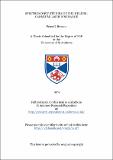Files in this item
Spectroscopic studies of the helium-cadmium laser discharge
Item metadata
| dc.contributor.advisor | Maitland, Arthur | |
| dc.contributor.advisor | Dunn, Malcolm H. | |
| dc.contributor.author | Browne, Peter G. | |
| dc.coverage.spatial | 125 p. | en_US |
| dc.date.accessioned | 2018-06-18T09:20:49Z | |
| dc.date.available | 2018-06-18T09:20:49Z | |
| dc.date.issued | 1974-07 | |
| dc.identifier.uri | https://hdl.handle.net/10023/14157 | |
| dc.description.abstract | The techniques of absorption and perturbation spectroscopy have been applied to the He-Cd laser discharge to determine species densities, excitation rates and de-excitation rates of relevance to laser oscillation on transitions in the cadmium ion. The first section, of this work describes the use of a line absorption technique to measure helium singlet and triplet metastable densities in a 3 mm bore capillary tube for both pure helium discharges (current range 10 - 200 mA., pressure range 0.5 - 15 torr) and for He-Cd discharges. For the pure helium discharge, with constant discharge current, the singlet and triplet densities show pronounced maxima of 2 X 10<super>12</super> cm<super> -3</super> and 9 x 10<super>12</super> cm<super>-3</super> respectively around 2 torr. At constant pressure the metastable densities saturate for currents above about 20 mA. The measured triplet densities are in fair agreement with values calculated using known cross-sections for production and loss processes. The addition of cadmium vapour has two principal effects: the metastable populations are almost halved when the optimum cadmium pressure for lasing is present while the current saturation is displaced towards higher currents (60 - 120 mA). The observed optimum performance of the He-Cd laser with respect to discharge current, helium filling pressure and cadmium partial pressure is related directly to the behaviour of the helium metastable densities as these parameters are varied. The second section describes the application of the technique of perturbation spectroscopy to the helium-cadmium laser. Chopping the radiation field inside the cavity of the later operating at 4416A induces perturbations in the populations of the 5s2 2D3/2,5/2 and 5p 2P3/2 levels of the cadmium ion. Analysis of the perturbations of the 5p 2P3/2 and 5s2 2P3/2 populations shows that the ratio of non-radiative to radiative de-excitation rates for the latter level (the upper level of the 4416A laser transition) is 0.9 +/- 0.2, with little dependence on discharge conditions. From the 5s2 2D3/2 population changes the cross-section for excitation of this level from the 5s2 2D5/2 level by electron collisions is found to be ~ 7 x 10<super>-16</super> cm2. | en_US |
| dc.language.iso | en | en_US |
| dc.publisher | University of St Andrews | |
| dc.subject.lcc | TK7872.L3B8 | |
| dc.subject.lcsh | Lasers | |
| dc.title | Spectroscopic studies of the helium-cadmium laser discharge | en_US |
| dc.type | Thesis | en_US |
| dc.type.qualificationlevel | Doctoral | en_US |
| dc.type.qualificationname | PhD Doctor of Philosophy | en_US |
| dc.publisher.institution | The University of St Andrews | en_US |
This item appears in the following Collection(s)
Items in the St Andrews Research Repository are protected by copyright, with all rights reserved, unless otherwise indicated.

